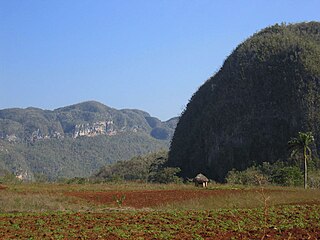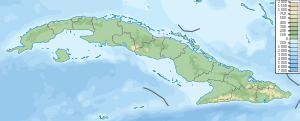
Russell Cave National Monument is a U.S. National Monument in northeastern Alabama, United States, close to the town of Bridgeport. The monument was established on May 11, 1961, when 310 acres (1.3 km2) of land were donated by the National Geographic Society to the American people. It is now administered and maintained by the National Park Service. The National Monument was listed on the National Register of Historic Places on October 15, 1966.

A cenote is a natural pit, or sinkhole, resulting from the collapse of limestone bedrock that exposes groundwater underneath. Especially associated with the Yucatán Peninsula of Mexico, cenotes were sometimes used by the ancient Maya for sacrificial offerings.

Sagua la Grande is a municipality and city located on the north coast of the province of Villa Clara in central Cuba, on the Sagua la Grande River. The city is close to Mogotes de Jumagua, limestone cliffs. Many cays of the Sabana-Camaguey Archipelago are located off the northern coast.

The Wombeyan Caves are caves that have formed in marble, in the Wombeyan Karst Conservation Reserve, New South Wales, Australia. Wombeyan Caves is a tourist attraction and local holiday area, as well as a reserve for endangered species, such as several species of wallaby, bird, possum, and wombat.

The Caverns of Sonora, a National Natural Landmark, is a unique cave located 8 miles (13 km) west of the small city of Sonora, the seat of Sutton County, Texas. It is a world-class cave because of its stunning array of calcite crystal formations, especially helictites. These helictites are found in extreme abundance, often with a rare purity and complexity. One formation is so densely packed with them, it has been dubbed the "snake pit". The founder of the National Speleological Society, Bill Stephenson, said of the cave after his first visit: "This is the most indescribably beautiful cave in the world, its beauty cannot be exaggerated, not even by a Texan."

Alejandro de Humboldt National Park is a national park in the Cuban provinces of Holguín and Guantánamo. It is named after the German scientist Alexander von Humboldt who visited the island in 1800 and 1801. The park was inscribed as a UNESCO World Heritage Site in 2001 for of its size, altitude range, complex lithology, landform diversity, and wealth of endemic flora and fauna.

Illinois Caverns is a state natural area in the New Design Precinct of Monroe County, Illinois. It features Illinois Caverns which is alternatively known as Mammoth Cave of Illinois. Illinois Caverns is the second-largest cave in Illinois and has more than 9.6 km of passages. The cave has a constant temperature of 58 °F (14 °C), and portions flood during wet weather. Passages can be 20 feet (6.1 m) high and just as wide. It is located off Illinois Route 3, south of Waterloo, near the unincorporated community of Burksville.

The Wellington Caves are a group of limestone caves located 8 kilometres (5.0 mi) south of Wellington, New South Wales, Australia.

Troglofauna are small cave-dwelling animals that have adapted to their dark surroundings. Troglofauna and stygofauna are the two types of subterranean fauna. Both are associated with subterranean environments – troglofauna are associated with caves and spaces above the water table and stygofauna with water. Troglofaunal species include spiders, insects, myriapods and others. Some troglofauna live permanently underground and cannot survive outside the cave environment. Troglofauna adaptations and characteristics include a heightened sense of hearing, touch and smell. Loss of under-used senses is apparent in the lack of pigmentation as well as eyesight in most troglofauna. Troglofauna insects may exhibit a lack of wings and longer appendages.

Viñales Valley is a karstic depression in Cuba. The valley has an area of 132 km2 (51 sq mi) and is located in the Sierra de los Órganos mountains, just north of Viñales in the Pinar del Río Province.

Eugenio de Bellard Pietri was a noted speleologist. He was the founder of speleology in Venezuela and a member of the Academy of Sciences and Letters of Venezuela, Vice-President of the Venezuelan Society of Natural Sciences and Director of its Speleological groups since 1952 when he founded this section. He was also a member of several Speleological and Conservation societies such as the French Federation of Speleology, the Explorers Club and the National Speleological Society (USA).
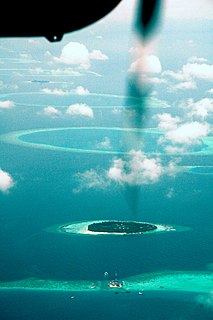
The wildlife of Maldives includes the flora and fauna of the islands, reefs, and the surrounding ocean.
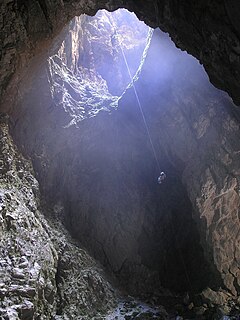
Caving in New Zealand is an established hobby as well as being a part of commercial tourism.

Cuchillas del Toa is a Biosphere Reserve in Cuba. It is located in the eastern part of the country, mostly in the Guantánamo Province and reaching to the north into the Holguín Province. Most of the reserve is established in the drainage area of the Toa River, which flows for 118 km (73 mi) to the Atlantic Ocean in Baracoa.
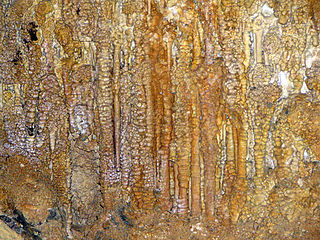
Risovača Cave, is situated at the very entrance of the town of Aranđelovac in central Serbia around 17 m (56 ft) above the Kubršnica river valley. It is one of the most important archaeological sites of the Palaeolithic in Serbia besides the Gradac Cave near Kragujevac. Its discovery confirmed the assumed existence of the Paleolithic culture south of the Sava-Danube line and provided new information on the life of prehistoric humans in Europe.
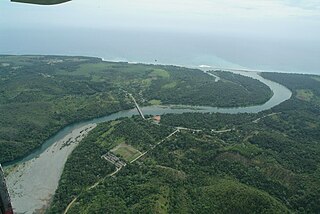
The Toa is a river located in the Guantánamo Province of Cuba, which flows across the country. This river is 131 kilometers long and has 72 tributaries. The Toa river is well known for its crystal clear waters.
Devon contains some limestone areas mainly on the eastern side of Dartmoor. The River Dart has created several caves along its fringes. There are few caves with active streamways in Devon, excluding the Bakers Pit streamway. Devon also has its own species of cave shrimp.

Indiana Caverns is part of the Binkley Cave system near Corydon, Indiana.

Windmill Hill Cavern is a limestone cave system in the town of Brixham, Devon. It was discovered in 1858 and later excavated by a team led by the geologist William Pengelly, who found proof that humans co-existed with extinct British fauna.

